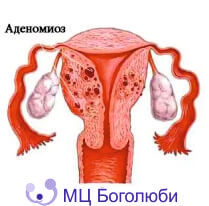Before we start talking about adenomyosis, we turn to the explanatory dictionary and clarify for ourselves what the «endometrium» and «myometrium». are. So, the endometrium is the mucous membrane lining the internal cavity of the uterus, and the myometrium is the muscle layer of the uterine wall, located between the endometrium and the serous (external) membrane of the organ.
What is uterine adenomyosis?
Uterine adenomyosis - is a benign pathological condition in which part of the endometrial tissue invades the myometrium. In simple words, adenomyosis occurs when endometrial cells grow in places where they should not be. Adenomyosis should not be confused with endometriosis. In the latter case, endometrial tissues are localized outside the uterus, growing in the pelvic organs and not only (ovaries, fallopian tubes, ureter, lungs, vulva, etc.).
Uterine adenomyosis and cancer are completely different diseases, although they have similar symptoms. Therefore, it is very important to make the correct diagnosis.
Causes of adenomyosis
The exact causes of adenomyosis are still unclear. Although a statistical analysis of scientific works devoted to the disease makes it possible to observe a certain relationship between the onset of the disease and some factors, in particular, such as:
- ubal ligation;
- abortion;
- frequent childbirth;
- surgical interventions in the uterine cavity (for example, removal of fibroids).
Many foreign experts suggest that adenomyosis is genetic in nature, and they believe that some women have a hereditary predisposition to the disease. Bearing in mind that mainly women aged 35 to 50 years are susceptible to adenomyosis, it is quite likely that the above phenomenon also depends on hormonal changes.
Symptoms of adnomyosis and diagnostics
The course of the disease is often asymptomatic. It turns out to detect the disease "by accident" during a routine gynecological examination. But it also happens that adonomyosis makes itself felt with the help of such signs as:
- anomalous uterine bleeding (for example, hypermenorrhea);
- painful menstruation (dysmenorrhea);
- pain during intercourse (dyspareunia).
Even the presence of large dense blood clots during menstruation should alert a woman. The uterus, suffering from adenomyosis of the patient, can double or even triple in size.
Even the presence of large dense blood clots during menstruation should alert a woman. The uterus, suffering from adenomyosis of the patient, can double or even triple in size. The disease is usually diagnosed with transvaginal ultrasound. . Classical suprapubic ultrasound does not provide unambiguous confirmation of the correct diagnosis
Uterine adenomyosis treatment
The treatment of the disease varies, depending on the severity of the condition and age of the patient. When it is found that adenomyosis is closely associated with an excess of estrogen in the blood, the doctor prescribes hormone therapy. Some experts believe that even daily transvaginal use of creams with progesterone can alleviate the symptoms of the disease.
Surgical removal of the uterus is indicated in difficult cases, especially when the patient is young and complains of severe pain that adversely affects everyday activities. It should be noted that all symptoms of adenomyosis, as a rule, disappear as soon as a woman crosses the border of menopause.
















